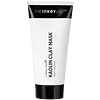What's inside
What's inside
 Key Ingredients
Key Ingredients

 Benefits
Benefits

 Concerns
Concerns

 Ingredients Side-by-side
Ingredients Side-by-side

Water
Skin ConditioningKaolin
AbrasiveGlyceryl Stearate Se
EmulsifyingCoco-Caprylate/Caprate
EmollientPolysorbate 20
EmulsifyingPropylene Glycol
HumectantSorbitan Stearate
EmulsifyingCetyl Alcohol
EmollientGlyceryl Stearate
EmollientPEG-100 Stearate
Bentonite
AbsorbentCharcoal Powder
AbrasiveCI 77891
Cosmetic ColorantCeramide AP
Skin Conditioning1,2-Hexanediol
Skin ConditioningTocopheryl Acetate
AntioxidantCitric Acid
BufferingPhenoxyethanol
PreservativeMagnesium Aluminum Silicate
AbsorbentXanthan Gum
EmulsifyingTrisodium Ethylenediamine Disuccinate
Water, Kaolin, Glyceryl Stearate Se, Coco-Caprylate/Caprate, Polysorbate 20, Propylene Glycol, Sorbitan Stearate, Cetyl Alcohol, Glyceryl Stearate, PEG-100 Stearate, Bentonite, Charcoal Powder, CI 77891, Ceramide AP, 1,2-Hexanediol, Tocopheryl Acetate, Citric Acid, Phenoxyethanol, Magnesium Aluminum Silicate, Xanthan Gum, Trisodium Ethylenediamine Disuccinate
Water
Skin ConditioningKaolin
AbrasiveAloe Barbadensis Leaf Juice
Skin ConditioningGlycerin
HumectantGlyceryl Stearate
EmollientCarthamus Tinctorius Seed Oil
MaskingStearic Acid
CleansingHelianthus Annuus Seed Oil
EmollientCetearyl Alcohol
EmollientMagnesium Aluminum Silicate
AbsorbentSodium Stearate
CleansingSodium Magnesium Silicate
Phenoxyethanol
PreservativeDimethyl Sulfone
SolventCentella Asiatica Extract
CleansingGlyceryl Caprylate
EmollientDecyl Glucoside
CleansingCellulose Gum
Emulsion StabilisingCocos Nucifera Oil
MaskingCetyl Alcohol
EmollientEthylhexylglycerin
Skin ConditioningSodium Carbomer
Emulsion StabilisingTocopherol
AntioxidantMacrocystis Pyrifera Extract
Skin ConditioningSea Water Extract
Skin ConditioningChondrus Crispus Extract
Skin ConditioningVitis Vinifera Seed Oil
EmollientLonicera Caprifolium Flower Extract
PerfumingSodium Hydroxide
BufferingLonicera Japonica Leaf Extract
Skin ConditioningTocopheryl Acetate
AntioxidantPanthenol
Skin ConditioningOryza Sativa Bran Oil
EmollientGeranium Maculatum Extract
TonicTaraxacum Officinale Extract
Skin ConditioningEquisetum Arvense Extract
AstringentSpirulina Maxima Extract
SmoothingPrunus Armeniaca Kernel Oil
MaskingWater, Kaolin, Aloe Barbadensis Leaf Juice, Glycerin, Glyceryl Stearate, Carthamus Tinctorius Seed Oil, Stearic Acid, Helianthus Annuus Seed Oil, Cetearyl Alcohol, Magnesium Aluminum Silicate, Sodium Stearate, Sodium Magnesium Silicate, Phenoxyethanol, Dimethyl Sulfone, Centella Asiatica Extract, Glyceryl Caprylate, Decyl Glucoside, Cellulose Gum, Cocos Nucifera Oil, Cetyl Alcohol, Ethylhexylglycerin, Sodium Carbomer, Tocopherol, Macrocystis Pyrifera Extract, Sea Water Extract, Chondrus Crispus Extract, Vitis Vinifera Seed Oil, Lonicera Caprifolium Flower Extract, Sodium Hydroxide, Lonicera Japonica Leaf Extract, Tocopheryl Acetate, Panthenol, Oryza Sativa Bran Oil, Geranium Maculatum Extract, Taraxacum Officinale Extract, Equisetum Arvense Extract, Spirulina Maxima Extract, Prunus Armeniaca Kernel Oil
 Reviews
Reviews

Ingredients Explained
These ingredients are found in both products.
Ingredients higher up in an ingredient list are typically present in a larger amount.
Cetyl Alcohol is a fatty alcohol. Fatty Alcohols are most often used as an emollient or to thicken a product.
Its main roles are:
Though it has "alcohol" in the name, it is not related to denatured alcohol or ethyl alcohol.
The FDA allows products labeled "alcohol-free" to have fatty alcohols.
Learn more about Cetyl AlcoholGlyceryl Stearate is a mix of glycerin and stearic acid.
It is used to stabilize the mixing of water and oil ingredients. By preventing these ingredients from separating, it can help elongate shelf life. It can also help thicken the product's texture.
As an emollient, it helps soften skin and supports barrier-replenishing ingredients.
In cosmetics, Glyceryl Stearate is often made from vegetable oils or synthetically produced.
This ingredient may not be fungal-acne safe
Fun fact: The human body also creates Glyceryl Stearate naturally.
Learn more about Glyceryl StearateKaolin is a clay. It is used for oil control and to help minimize pores. Like other clays, kaolin has the ability to absorb excess sebum or oil. This can help clean out pores and mattify the skin.
Some types of kaolin may have exfoliating properties. When water is added to kaolin, it becomes a paste with small abrasive particles.
Most kaolin is a white color, but may be pink/orange/red depending on where it comes from.
The name 'kaolin' comes from a Chinese village named 'Gaoling'. Kaolin clay comes from rocks rich in kaolinite. Kaolinite, the mineral, has a silicate layered structure. Kaolinite is formed from chemical weathering of aluminum siilicate minerals.
Besides skincare, kaolin is commonly used to make glossy paper, in ceramics, toothpaste, and as medicine to soothe stomach issues.
Learn more about KaolinMagnesium Aluminum Silicate is a type of silica. It comes from naturally occuring minerals such as silicate ores and clay.
Magnesium aluminum silicate is used for enhancing texture and as an absorbent. Due to its large molecular size, it is unable to be absorbed into the skin.
Like other types of silica, this ingredient can be used to thicken a product. As an absorbent, it may be used to absorb extra water or help prevent clumping.
Although “aluminum” in an ingredient name can raise red flags for some consumers, the form and usage context matter significantly. For typical topical applications, there is no substantial evidence of health risks - such as cancer, neurotoxicity, or systemic “aluminum overload.”
Learn more about Magnesium Aluminum SilicatePhenoxyethanol is a preservative that has germicide, antimicrobial, and aromatic properties. Studies show that phenoxyethanol can prevent microbial growth. By itself, it has a scent that is similar to that of a rose.
It's often used in formulations along with Caprylyl Glycol to preserve the shelf life of products.
Tocopheryl Acetate is AKA Vitamin E. It is an antioxidant and protects your skin from free radicals. Free radicals damage the skin by breaking down collagen.
One study found using Tocopheryl Acetate with Vitamin C decreased the number of sunburned cells.
Tocopheryl Acetate is commonly found in both skincare and dietary supplements.
Learn more about Tocopheryl AcetateWater. It's the most common cosmetic ingredient of all. You'll usually see it at the top of ingredient lists, meaning that it makes up the largest part of the product.
So why is it so popular? Water most often acts as a solvent - this means that it helps dissolve other ingredients into the formulation.
You'll also recognize water as that liquid we all need to stay alive. If you see this, drink a glass of water. Stay hydrated!
Learn more about Water